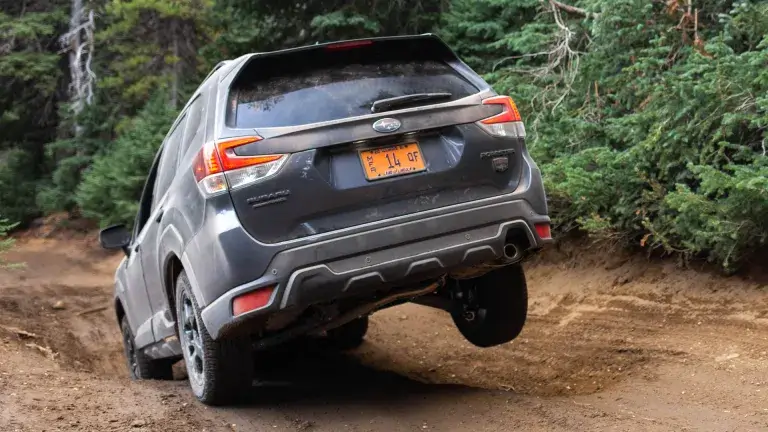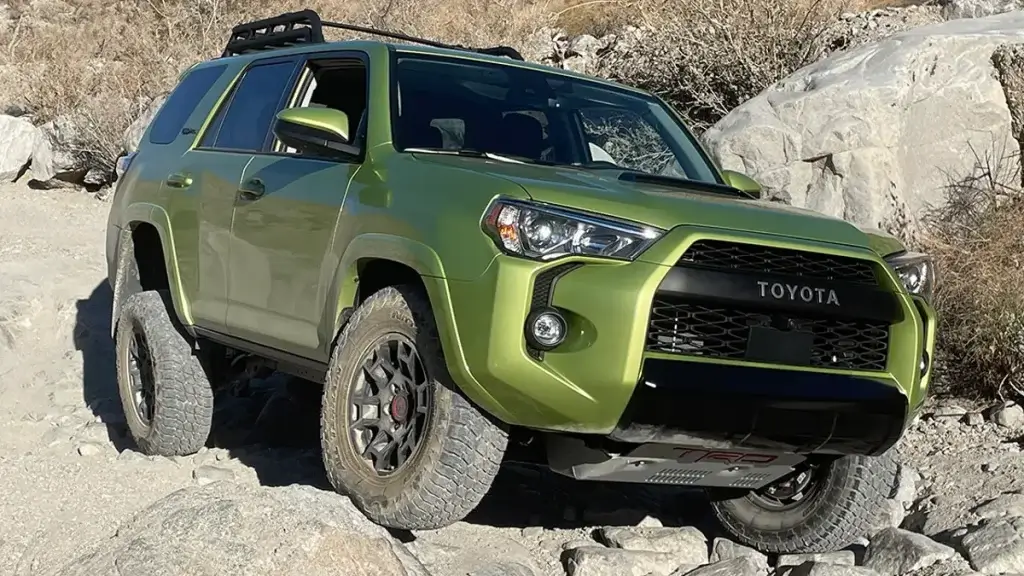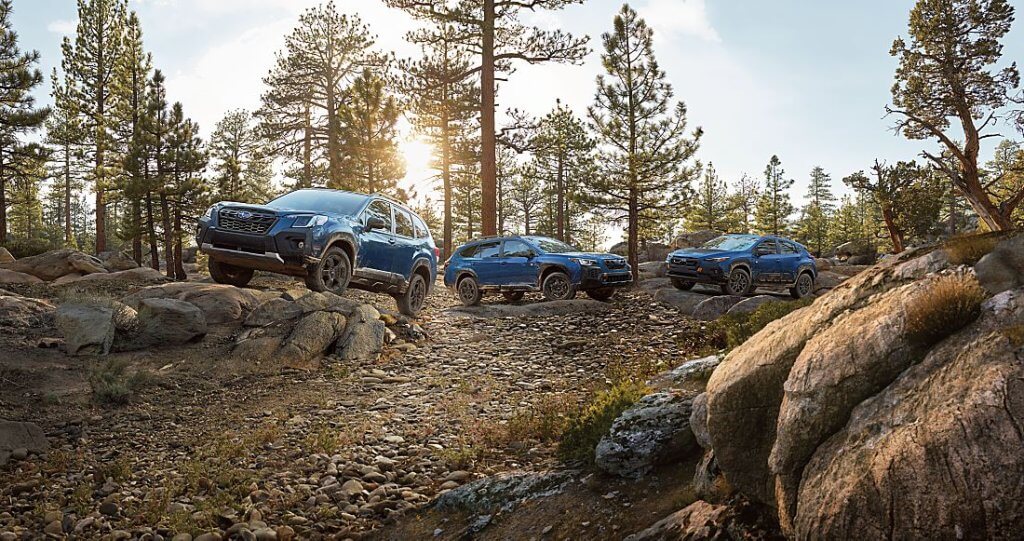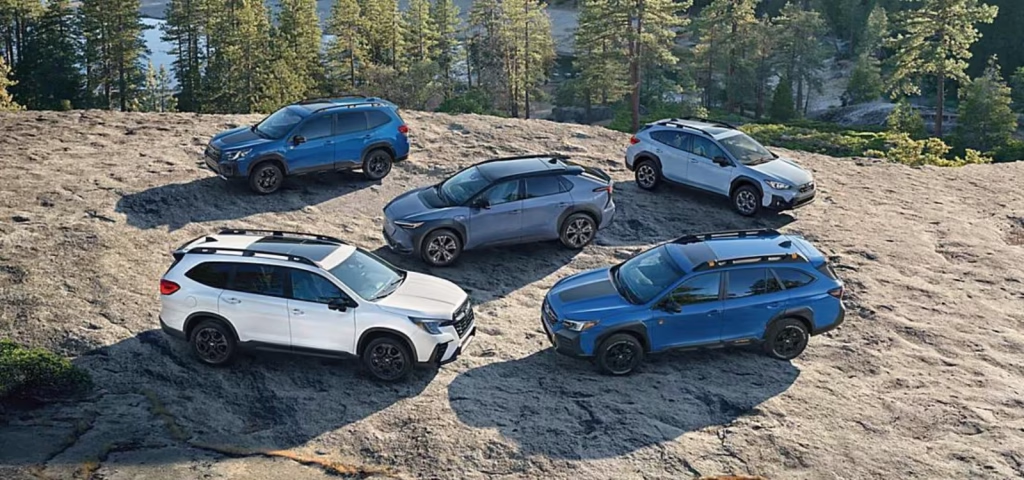By Bryan Jacobson | VAOffRoad.org
Subaru has built a strong reputation as the go-to brand for outdoor enthusiasts. With models like the Outback Wilderness, Crosstrek, and Forester, the company has found a loyal following among hikers, campers, and snow-loving adventurers. Subaru’s standard symmetrical all-wheel drive (AWD) system, decent ground clearance, and rugged marketing make it a common sight at trailheads across Virginia and beyond.
But let’s be clear: Subaru AWD vehicles are not off-road vehicles. They can handle gravel roads, snow-covered streets, and light fire roads, but beyond that, their limitations quickly become apparent. When it comes to off-road capability—especially in moderate to advanced terrain—they simply don’t compare to true 4×4 systems found in vehicles like the Jeep Wrangler, Ford Bronco, Toyota 4Runner, or even modern off-road electric vehicles.
At VAOffRoad.org, we regularly encounter Subaru vehicles at the base of trails like Peters Mill Run, Flagpole Knob, and Shoe Creek. Some owners are surprised to learn that their adventure-ready-looking vehicle isn’t built to withstand rocks, deep ruts, steep climbs, and washed-out switchbacks. This article explains why Subaru’s AWD system isn’t cut out for true off-roading, and how it compares to proper 4WD systems in today’s 2025 off-road vehicle market.

Subaru’s AWD System: What It Is and Isn’t
Subaru’s Symmetrical All-Wheel Drive is often misunderstood. Many buyers assume AWD and 4WD are interchangeable terms—but they’re not.
Subaru AWD is a full-time, single-speed AWD system. Torque is automatically split between the front and rear axles—usually with a default 60/40 bias on most models, though it varies depending on the vehicle and driving conditions. Subaru’s famed “symmetry” refers to the balanced layout of the engine and drivetrain, which helps improve stability and traction during inclement weather or on loose surfaces.
However, Subaru’s AWD system lacks key off-road features:
- No low-range transfer case for slow, controlled crawling.
- No locking differentials—not even a mechanical limited-slip.
- No solid axles or long-travel suspension.
- Limited traction control tuning and software that prioritizes on-road safety over off-road performance.
While Subaru has added features like X-Mode to some of its Wilderness trims, this is a traction assist system—not a substitute for real 4WD hardware. X-Mode enhances throttle response and traction control logic for low-speed scenarios, but it can’t compensate for a lifted wheel, torque-less differentials, or limited ground clearance.

Real-World Trail Failures: Subarus on the Rocks
Here in Virginia, we see a growing number of Subarus venturing out onto terrain they simply aren’t equipped for. The result? A rising number of recoveries, broken bumpers, transmission overheating, and damaged undercarriages.
Common issues seen on trails:
- Wheel Lift: Subarus often lift a wheel off the ground when approaching uneven ruts, leading to a loss of forward motion.
- Overheating CVTs: Many Subaru models use Continuously Variable Transmissions (CVTs), which aren’t designed to withstand the torque load of climbing hills or crawling through technical rock sections.
- Weak Undercarriages: Subarus have minimal factory skid plates. Hitting rocks or stumps can bend suspension components or puncture oil pans.
- Low Approach Angles: Front and rear bumpers are designed for urban roads, not trail obstacles. This leads to frequent bumper damage or stuck vehicles.
Virginia trail examples:
- Peters Mill Run: A mild trail that gets progressively harder. Subarus often turn back halfway or need spotting over deeper ruts.
- Shoe Creek: Washed-out creek beds and sharp descents are too aggressive for most AWD systems.
- Flagpole Knob (via Union Springs): Multiple climbs, loose rocks, and off-camber sections test even lifted 4×4 rigs.
The truth is, Subarus can get you to the trailhead—but they shouldn’t go beyond it.

How Subaru Compares to True Off-Road Systems in 2025
Let’s compare Subaru AWD with some of the top-tier 4×4 systems available in 2025. These aren’t just mechanical differences—they’re trail-proven advantages that matter when conditions get rough.
1. Jeep Wrangler & Gladiator (2025)
- 4WD System: Rock-Trac or Command-Trac with selectable 4LO.
- Axles: Dana 44 solid axles front and rear.
- Lockers: Available front and rear locking differentials.
- Suspension: Long-travel coil suspension with high articulation.
- Ground Clearance: Up to 12.9″ (Rubicon).
- Aftermarket: Endless lift kits, bumpers, skids, snorkels, etc.
Why it matters: The Wrangler remains the gold standard for trail-ready 4x4s. It’s built from the frame up for rock crawling, mud bogging, and backcountry exploration. Subaru can’t even enter the same conversation.
2. Ford Bronco (2025)
- 4WD System: Advanced 4×4 with automatic or manual transfer case.
- Tech: GOAT Modes, Trail Turn Assist, One-Pedal Drive for crawling.
- Lockers & Disconnects: Front and rear lockers; sway bar disconnect.
- Ground Clearance: 11.6″ on Badlands trim.
Why it matters: The Bronco combines serious trail tech with modern comfort. Its articulation, power, and off-road driver aids allow it to go where Subarus physically can’t.
3. Toyota 4Runner (2025 Redesign)
- Platform: Now based on the TNGA-F body-on-frame chassis.
- 4WD: Part-time 4WD with 4LO, Crawl Control, and Multi-Terrain Select.
- Lockers: Rear locker standard on TRD Off-Road/Pro trims.
- Suspension: Improved travel and durability in the 2025 model.
- Ground Clearance: 9.8″+ with skids and off-road angles that matter.
Why it matters: Toyota knows reliability and off-road capability. The 4Runner is a tank compared to any Subaru crossover, with far more recovery and survival capability on trails.

4. Chevy Colorado ZR2 (2025)
- 4WD System: 2-speed transfer case, Multimatic DSSV dampers.
- Lockers: Front and rear electronic locking diffs.
- Ground Clearance: 10.7″, armored underbody.
- Suspension: High-performance off-road shocks, increased travel.
Why it matters: The ZR2 offers cutting-edge off-road suspension and protection. Subaru doesn’t offer a single one of these features.
5. Rivian R1T / R1S (2025)
- Drive System: Quad-motor AWD with torque vectoring.
- Clearance: 14.9″ adjustable air suspension.
- Trail Tech: Driver-controlled power to each wheel.
- Water Fording: Over 3 feet.
Why it matters: Rivian’s EVs are redefining off-road traction by letting each wheel act independently. Subaru’s AWD is primitive by comparison.
Ground Clearance and Angles: The Devil’s in the Details
Many Subaru fans point to 9.2–9.5 inches of clearance on the Outback Wilderness or Crosstrek Wilderness. And yes, on paper, this sounds good. But clearance alone doesn’t define off-road capability.
- Approach/Departure Angles: Subarus have steep bumper overhangs. You’ll scrape just trying to climb a basic obstacle.
- Breakover Angle: Long wheelbase and short suspension travel lead to bottoming out.
- Lack of Articulation: Subarus don’t twist well. One lifted wheel means you’re done.
Compare that to the Wrangler Rubicon’s approach angle of 47.4°, or the Bronco’s 11+ inches of clearance and modular bumpers designed to take hits, and the difference becomes obvious.
When Subaru Is the Right Tool
All this isn’t to say Subaru AWD is bad. It’s great—for what it’s designed to do:
- Light-duty off-pavement travel.
- Snow, sleet, and mud-covered roads.
- Trailhead access.
- Overland-style camping where no serious obstacles exist.
For many outdoor enthusiasts who spend 90% of their time on the road and only venture onto light gravel or fire roads, Subaru is perfect. You get solid MPG, comfortable ride quality, and AWD confidence in weather.
Just don’t confuse “off-road lifestyle” with actual off-road use.

The Social Media Effect: Subaru Off-Road Culture
Instagram and TikTok are full of lifted Crosstreks and rooftop tents. The #SubieOffRoad trend is real. But this visual culture has led many to believe Subarus are serious trail rigs. Unfortunately, this illusion often results in damaged vehicles and difficult recoveries.
Trail-ready looks do not equal capability. A 2” lift and all-terrains don’t give you a transfer case or lockers. We’ve seen many novice drivers misled by off-road influencer culture into thinking they’re ready for trails like Union Springs or Taskers Gap—only to learn the hard way that there’s a big difference between a dirt road and a real trail.
Conclusion: Know Before You Go
Subaru makes reliable, comfortable AWD vehicles that shine in inclement weather and on gravel. But they are not off-road vehicles, and it’s critical for drivers to know the difference. Subaru’s AWD system, while excellent for what it is, simply isn’t built to handle the challenges of Virginia’s backcountry trails or beyond.
If your idea of adventure includes technical terrain, deep ruts, steep climbs, or rock crawling, a true 4×4 is what you need. And that means choosing a platform that’s built for it from the frame up—Jeep, Ford, Toyota, or others.
At VAOffRoad.org, we’re here to help you find the right rig, the right trails, and the right community. Whether you’re a beginner or a seasoned wheeler, join our trail rides, explore our maps, and support our mission to protect and promote Virginia’s off-road community.
And if you’re rolling up in a Subaru—no shame. Just know your limits. Park at the trailhead, pop your tent, and enjoy the view. Just maybe leave the creek crossings to the lockers and low-range crew.



No responses yet